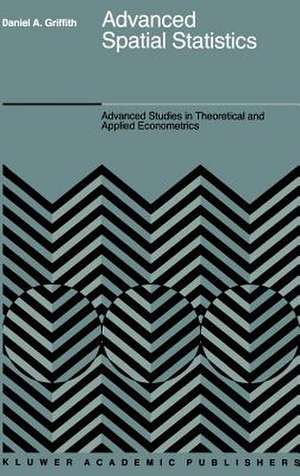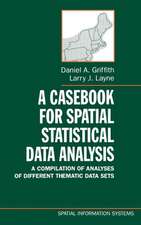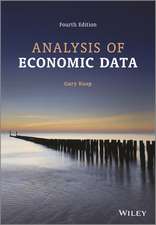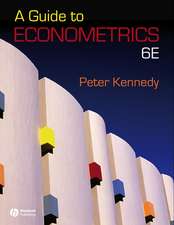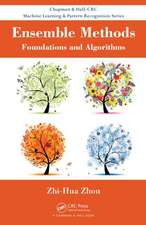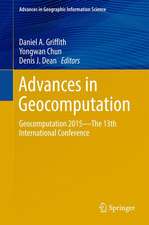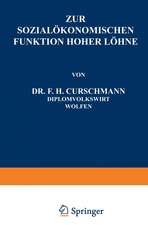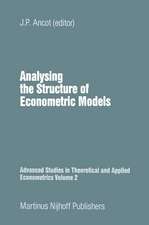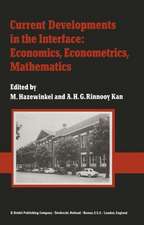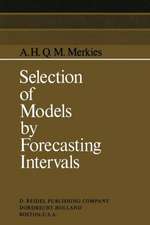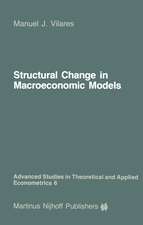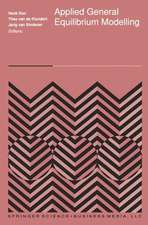Advanced Spatial Statistics: Special Topics in the Exploration of Quantitative Spatial Data Series: Advanced Studies in Theoretical and Applied Econometrics, cartea 12
Autor Daniel A. Griffithen Limba Engleză Hardback – 30 apr 1988
| Toate formatele și edițiile | Preț | Express |
|---|---|---|
| Paperback (1) | 1216.65 lei 6-8 săpt. | |
| SPRINGER NETHERLANDS – 20 sep 2011 | 1216.65 lei 6-8 săpt. | |
| Hardback (1) | 1222.62 lei 6-8 săpt. | |
| SPRINGER NETHERLANDS – 30 apr 1988 | 1222.62 lei 6-8 săpt. |
Din seria Advanced Studies in Theoretical and Applied Econometrics
- 20%
 Preț: 568.81 lei
Preț: 568.81 lei - 20%
 Preț: 817.34 lei
Preț: 817.34 lei - 24%
 Preț: 793.66 lei
Preț: 793.66 lei - 15%
 Preț: 640.06 lei
Preț: 640.06 lei -
 Preț: 383.12 lei
Preț: 383.12 lei - 18%
 Preț: 950.33 lei
Preț: 950.33 lei - 18%
 Preț: 950.03 lei
Preț: 950.03 lei - 15%
 Preț: 637.41 lei
Preț: 637.41 lei - 15%
 Preț: 645.79 lei
Preț: 645.79 lei -
 Preț: 387.38 lei
Preț: 387.38 lei - 18%
 Preț: 945.30 lei
Preț: 945.30 lei - 18%
 Preț: 949.73 lei
Preț: 949.73 lei -
 Preț: 386.22 lei
Preț: 386.22 lei - 18%
 Preț: 949.73 lei
Preț: 949.73 lei - 18%
 Preț: 952.40 lei
Preț: 952.40 lei - 18%
 Preț: 945.47 lei
Preț: 945.47 lei - 18%
 Preț: 954.45 lei
Preț: 954.45 lei - 18%
 Preț: 947.35 lei
Preț: 947.35 lei - 15%
 Preț: 645.60 lei
Preț: 645.60 lei - 18%
 Preț: 975.43 lei
Preț: 975.43 lei - 18%
 Preț: 1226.24 lei
Preț: 1226.24 lei -
 Preț: 392.60 lei
Preț: 392.60 lei - 15%
 Preț: 632.22 lei
Preț: 632.22 lei -
 Preț: 382.36 lei
Preț: 382.36 lei - 15%
 Preț: 642.18 lei
Preț: 642.18 lei - 18%
 Preț: 951.59 lei
Preț: 951.59 lei
Preț: 1222.62 lei
Preț vechi: 1491.00 lei
-18% Nou
Puncte Express: 1834
Preț estimativ în valută:
233.94€ • 244.92$ • 193.58£
233.94€ • 244.92$ • 193.58£
Carte tipărită la comandă
Livrare economică 05-19 aprilie
Preluare comenzi: 021 569.72.76
Specificații
ISBN-13: 9789024736270
ISBN-10: 9024736277
Pagini: 292
Ilustrații: XIV, 274 p.
Dimensiuni: 155 x 235 x 21 mm
Greutate: 0.59 kg
Ediția:1988
Editura: SPRINGER NETHERLANDS
Colecția Springer
Seria Advanced Studies in Theoretical and Applied Econometrics
Locul publicării:Dordrecht, Netherlands
ISBN-10: 9024736277
Pagini: 292
Ilustrații: XIV, 274 p.
Dimensiuni: 155 x 235 x 21 mm
Greutate: 0.59 kg
Ediția:1988
Editura: SPRINGER NETHERLANDS
Colecția Springer
Seria Advanced Studies in Theoretical and Applied Econometrics
Locul publicării:Dordrecht, Netherlands
Public țintă
ResearchCuprins
1. Introduction to spatial statistics and data handling.- 1.1. A brief historical background.- 1.2. The principal problem of spatial statistics.- 1.3. Spatial sampling perspectives.- 1.4. Models of spatial autocorrelation.- 1.5. Towards a theory of spatial statistics.- 1.6 References.- Appendix 1A: Derivation of the expected value of MC.- Appendix 1B: Derivation of the expected value of GR.- 2. Developing a theory of spatial statistics.- 2.1. The small sample size problem.- 2.2. Finite versus infinite surfaces.- 2.3. Data transformations.- 2.4. Multivariate analysis.- 2.5. Higher order autoregressive models.- 2.6. Concluding comments.- 2.7. References.- 3. Areal unit configuration and locational information.- 3.1. Planar tessellations.- 3.2. Eigenfunction analysis of areal unit configuration tessellations.- 3.3. Selected applications of the principal eigenfunctions of matrix C.- 3.4. The modifiable areal unit problem.- 3.5. The importance of configurational information: a case study of Toronto.- 3.6. Implications.- 3.7. References.- 4. Reformulating classical linear statistical models.- 4.1. Autocorrelated errors models.- 4.2. Autocorrelated bivariate models.- 4.3. A spatially adjusted ANOVA model.- 4.4. The two-groups discriminant function model.- 4.5. Hypothesis testing and spatial dependence.- 4.6. Efficiency of spatial statistics estimators.- 4.7. Consistency of spatial statistics estimators.- 4.8. Conclusions.- 4.9. References.- 5. Spatial autocorrelation and spectral analysis.- 5.1. A brief background for spectral analysis.- 5.2. Relationships between autoregressive and spectral models.- 5.3. Defining the covariance matrix of a conditional spatial model using the spectral density function.- 5.4. Spectral analysis and two-dimensional shape measurement.- 5.5. Concluding comments.- 5.6. References.- 6. The missing data problem of a two-dimensional surface.- 6.1. The incomplete data problem statement.- 6.2. Background.- 6.3. Solutions available in commercial statistical packages.- 6.4. The spatial data problem.- 6.5. Properties of the conditional model when data are incomplete.- 6.6. An algorithm for the conditional spatial case.- 6.7. Constrained MLEs.- 6.8. Concluding comments.- 6.9. References.- Appendix 6A: FORTRAN subroutine.- 7. Correcting for edge effects in spatial statistical analyses.- 7.1. Problem statement.- 7.2. Major proposed solutions.- 7.3. An evaluation of the major proposed solutions.- 7.4. Conclusions and implications.- 7.5. References.- 8. Multivariate models of spatial dependence.- 8.1. A multivariate normal probability density function with spatial autocorrelation.- 8.2. Discerning latent structure in multivariate spatial data.- 8.3. Estimation problems.- 8.4. Selected empirical examples.- 8.5. Extensions to multivariate models in general.- 8.6. Concluding comments.- 8.7. References.- Appendix 8A: Rules for Kronecker products.- 9: Simulation experimentation in spatial analysis.- 9.1. Testing a null hypothesis of zero spatial autocorrelation.- 9.2. Generating autocorrelated pseudo-random numbers for two-dimensional surfaces.- 9.3. Background.- 9.4. Quality of the pseudo-random numbers.- 9.5. Variance reduction techniques.- 9.6. Selecting the number of replications r.- 9.7. Analysis of the simulation results for Chapter 6.- 9.8. Concluding comments.- 9.9. References.- 10. Summary and conclusions.- 10.1. Summary.- 10.2 Conclusions.- 10.3 References.
